ROYAL BALLET SLEEPING BEAUTY [20TH DEC'06]
 The Sleeping Beauty [photo by DaveM]
The Sleeping Beauty [photo by DaveM]Without a doubt, it was one of the best Sleeping Beauty evenings I have ever had. With the mixture of the misty fog and cold windy air of London on the other side of the Opera House gate, the Opera House is filled with comfort, warmth and opulence of the Christmas magic.
It was the final evening for Royal Ballet’s Sleeping Beauty with Marianela Nunez as Princess Aurora, Thiago Soares as Prince Florimund, Isabel McMeekan as Lilac Fairy and Genesia Rosato as Carabosse. And it was a treat to have Lauren Cuthbertson and Kenta Kura As Princess Florine and Bluebird.
Prologue
Boris Gruzin, prepared the orchestra with much oomph and gusto; bringing that extra warmth within the auditorium. The curtains rose to reveal the court of King Florestan and His Queen. Alastair Marriott as Cattalabutte was elegant and gave such delicate hand gestures. The sweeping action of his wrist was refined and exquisitely delivered. Gary Avis’s King Florestan proved to be strong and domineering, while Queen (Elizabeth McGorian) was endearing and motherly.
Lauren Cuthbertson and Steven McRae stood out exceptionally with strong stage presence as Fairy of the Enchanted Garden and her Cavalier. Both Ricardo Cervera and McRae’s batteries were sharp, crisp and clearly executed, probably the best beaters amongst the other Cavaliers. Fairy of the Crystal Fountain’s solo was performed with grace and beauty by the talented Alexandra Ansanelli. She made the solo looked exquisite and easy, it was probably the best person I have seen to perform this solo. Cuthbertson’s Fairy of the Enchanted Garden was also performed with charm and ease. Once again, Laura Morera’s Fairy of the Golden Vine was delivered with attack, crisp and style.
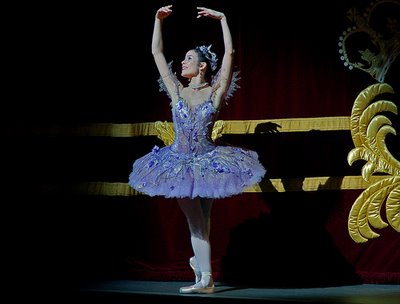 Curtain call: Isabel McMeekan as Lilac Fairy [photo by DaveM]
Curtain call: Isabel McMeekan as Lilac Fairy [photo by DaveM]Isabel McMeekan’s Lilac Fairy was carefully executed, projecting a clean and safe solo. However, one feels, Lilac Fairy seemed to be icy cold. Genesia Rosato’s Carabosse seemed to lack viciousness and strength of all great evilness. However, her costume looked like a great Christmas-inspired outfit; have the right colours, and theatrical glitz. The Rats were also brilliant with their leaps and rolling around. It must be a nightmare dancing in those heavy headgears in such dim lightings.
Act 1
Christopher Wheeldon’s Garland Dance was joyously danced by the company, and Aurora Friends’ sequences were clean and neat.
Princess Aurora was flawlessly performed by Marianela Nunez. Her entrance was lit up with warmth and radiance. Portraying as a cheeky, coquettish 16 year old princess, Nunez flavours her performance with fun, and fearless renvéses and pirouettes. There may be a couple of wobbles (if one is being picky and critical), in her balances, but she made it up with her double renvéses, and an exciting solo. Nunez’s solo was peerless. A lyrical dancer, who danced as if she was conducting the orchestra with her body, fully utilizing every notes on the score. What would Tchaikovsky say if he was here?
Act 2
Commendable work from the corp de ballet, simply spot on. Thiago’s Adagio solo was performed with ease, and grace. Flawless and totally in control of the stage and music. He sustained his jumps and landed without a sound; he managed his pirouettes carefully to finish neatly in arabesques. His characterisation was also commendable. His solo was thoroughly self-indulgent, sorrowful and longing. Nunez in Act 2 was divine. Very sincere pleadings and divine dancing. Nunez tackled her solo with strong and sustained envelopes, ensuring on each envelope, she lets her gesturing leg lingers and creeps down her supporting leg, while staying on pointe. As her legs are demonstrating the technical proficiency, her upper body delivered an endearing and fluid performance.
Act 3
The stage once again lit up with lavish and opulence. The flamboyant feathers, elaborated gold and salmon colour palette embraced a rich rococo atmosphere. The shimmering gold dusted trees for Red Riding Hood mimicked fragments of the Christmas trees.
Florestan and his Sisters were performed by Bennet Gartside, Laura Morera and Hikaru Kobayashi. Gartside managed to deliver his solo easily and neatly, but without the sparkles. One was surprised that after seeing his many Florestan that he has not manage any decent grand jetés. Morera led the first Sister’s solo with a chirpy personality to the dancing, once again, she handled the solo with ease and charm. Kobayashi, too, was immaculate in her solo, definitely a delight to watch.
 Curtain call from left: Laura Morera, Bennet Gartside and Hikaru Kobayashi as Prince Florestan and Sisters [photo by DaveM]
Curtain call from left: Laura Morera, Bennet Gartside and Hikaru Kobayashi as Prince Florestan and Sisters [photo by DaveM]Jonathan Howells and Iohna Loots as Puss-in-Boots and the petit White Cat. Both dancers seemed to be enjoying the work as much as the audience are. Caroline Duprot and David Pickering as the candid Red Riding Hood and the Wolf. Pickering gave good elevation despite his puffy Wolf suit and heavy head-dress.
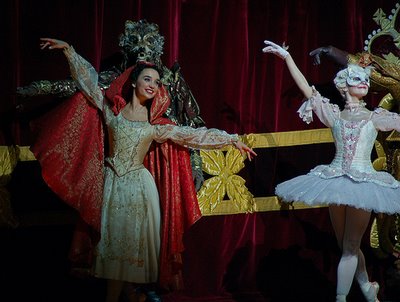 Curtain Call: Caroline Dupront as Red Riding Hood, and Iohna Loots as Puss in Boots [photo by DaveM]
Curtain Call: Caroline Dupront as Red Riding Hood, and Iohna Loots as Puss in Boots [photo by DaveM]Kenta Kura’s Bluebird was airy, giving sustained jumps and soft landings. Intensely bird-liked arms and a warmth stage presence with clean and clear beats but a lack of suppleness in the upper back for those temps du poisson. Cuthbertson’s Princess Florine was elegant and full of radiance. A bright and confidant performance that was executed with great ease and grace.
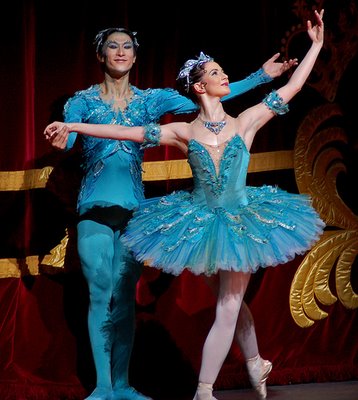 Curtain Call: Kenta Kura and Lauren Cuthbertson as Bluebird and Princess Florine [photo by DaveM]
Curtain Call: Kenta Kura and Lauren Cuthbertson as Bluebird and Princess Florine [photo by DaveM]  Marianela Nunez and Thiago Soares as Sleeping Beauty and Prince Florimund[photo by DaveM]In the Grand Pas de deux, Nunez and Soares once again illuminated the stage with their warmth presence. The adagio was sophisticatedly performed. Soares provided excellent support and complementing the ballerina’s lines. Amazing use of the body throughout the work from Nunez. An adrenaline-packed performance from Soares’ solo, with stunning turns, hovering jumps and luscious landings. At some point, one would think this lyrical danseur hovered in the air a little longer to enjoy the trailing beauty of the music. In the coda, Soares gave an explosive entrance and Nunez followed suit, and both finished with much exuberance.
Marianela Nunez and Thiago Soares as Sleeping Beauty and Prince Florimund[photo by DaveM]In the Grand Pas de deux, Nunez and Soares once again illuminated the stage with their warmth presence. The adagio was sophisticatedly performed. Soares provided excellent support and complementing the ballerina’s lines. Amazing use of the body throughout the work from Nunez. An adrenaline-packed performance from Soares’ solo, with stunning turns, hovering jumps and luscious landings. At some point, one would think this lyrical danseur hovered in the air a little longer to enjoy the trailing beauty of the music. In the coda, Soares gave an explosive entrance and Nunez followed suit, and both finished with much exuberance.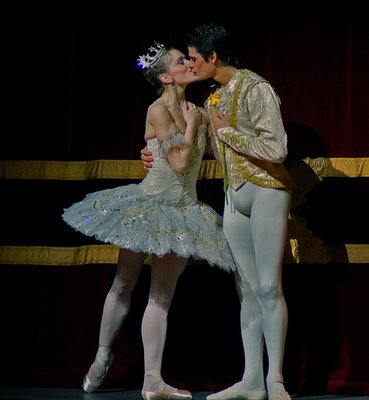
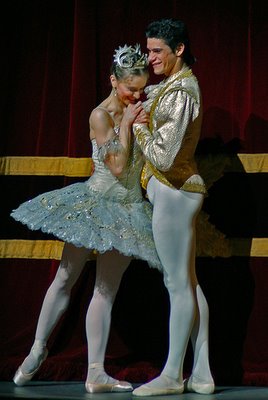
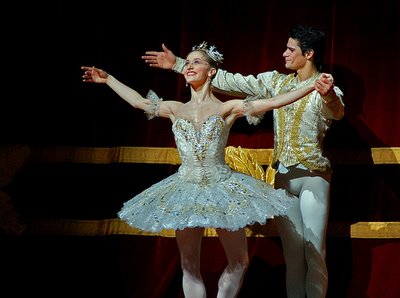 Curtain Call: Marianela Nunez and Thiago Soares as Sleeping Beauty and Prince Florimund[photo by DaveM]
Curtain Call: Marianela Nunez and Thiago Soares as Sleeping Beauty and Prince Florimund[photo by DaveM]The audience enjoyed the performance very much, and would be sad to see Sleeping Beauty put to rest for a while. As for me, this magical performance will always remain in my memory, for the experience I had, was unforgettable. All I can say was from the beginning of the performance, the orchestra warms up the theatre with their beautiful music, while Nunez and Thiago’s dancing warms our hearts.


